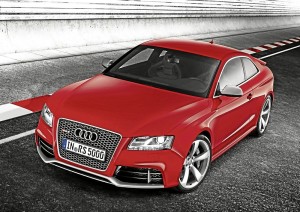Audi’s RS5 might be overshadowed by BMW’s M3 as the king of sedan-based 2-door sports coupes for fine handling and precision, and Mercedes-Benz’s mini hot-rod C63 coupe with its stonking Messchersmitt-sounding V8. But the coupe from Ingolstadt boasts a couple of technological advances to keep any car geek euphoric, poring over the technical details for hours on end.
Chief of these is the 4.2-liter gasoline-fed direct injection 4-cam 32-valve V8. Direct injection engines have the fuel fed directly into the combustion chamber instead of the intake tract and mixing with the incoming air. By directing fuel into the combustion chamber, less fuel is wasted as un-atomized fuel sticks to the walls of the intact tract, causing carbon build-up which absorbs even more unburnt fuel. This is called pumping loss. Another benefit is the precise metering afforded by injecting fuel directly into the combustion chamber as pumping losses are not exact and vary as the intake plenum and manifold heats up, causing more fuel to stick into it.
Engineers must then program a disproportionately large amount of fuel into the combustion process to take into consideration varying pumping losses. With direct injection, metering of fuel can be more precise. Less fuel wasted, less fuel consumed for pumping losses and lower emissions. The best part? Direct injection engines can run higher compression ratios (the ratio by which fuel and air are compressed, and with the help of a spark, is ignited to transform chemical energy, that is the air and fuel, into mechanical energy by means of a controlled explosion, which is the combustion process).
An engine that can run a higher compression ratio has the potential to yield more power by extracting more out of each part of fuel entering the engine. All in all, the RS5’s V8 engine produces 450 PSand 430 Newton-meters of torque. When coupled with Quattro AWD plus the amazingly efficient S-Tronic 7-speed dual-clutch transmission, all the available power is transmitted quickly to the ground, thrusting the heavy RS5 forward quickly. Paddle shifters help you get more performance by manually flicking gears and keeping them in-gear for challenging corners and overtaking maneuvers.
The Quattro AWD helps the RS5 become quick and agile through tight stuff. It feels like a grown-up Subaru STI or Mitsu Lan-Evo, but is more benign, handles more progressively and has far greater stability at higher speeds, thanks to the available traction and stability controls.
The front brakes are massive, measuring 380 mm with 6-piston Brembo calipers to haul down the 1800 kg coupe from serious speeds. Despite being built largely of aluminum form Audi’s Neckersaulm plant, the RS5 is weighed down by the heavy transmission and engine plus all the safety features of a modern high-performance coupe. It has a weight distribution of 57 percent at the front and 43 percent in the rear, a perfect recipe for understeer. But Audi has added a cornering-brake force distribution system that clamps down on the front inner wheels when turning to help steer the RS5 better, and a smart center differential that can send as much as 85-percent driving torque to the rear wheels to help the rear end rotate better. Under normal driving conditions, the RS5 delivers 60 percent of the power to the rear to help give it a more natural, RWD feel.
The RS5 also has some of the best seats in the house. Based on the RECARO Sporster CS seats that are ergonomically and crucially, orthopedically correct, these soft leather covered seats, which cost a staggering $8,000 each, gave my back much-needed rest and comfort during the past busy holiday season. If the seats don’t make you happy, the integrated Bang & Olufsen sound system will, with its 14 speakers, 10 amplified channels and a total of 500 watts of pure power. It handled everything from Bach’s Jesu Joy of Man’s Desiring to Katy Perry’s Teenage Dream perfectly.
As expected, everything is covered in leather, with the excellent Audi dash architecture inside that is elegant and very modern, with the Audi MMI carefully integrated into a myriad of buttons. Audi’s Drive Select offers a range of sport and comfort oriented settings for the power steering system’s heft, the speed of the S-Tronic transmission’s shifting and the ride-height and firmness of the suspension system, plus the sensitivity of the throttle to driver input.
And the all-important fuel economy question? I found myself gunning the throttle a lot whenever the roads cleared up, partly to make up time, but mostly to hear the wonderful burble of the V8, which sounds like warm thick cocoa going down your throat. My average for the whole weekend I had the Audi was an astonishing 6.5 km/liter against the expected 4.5 km/liter.


